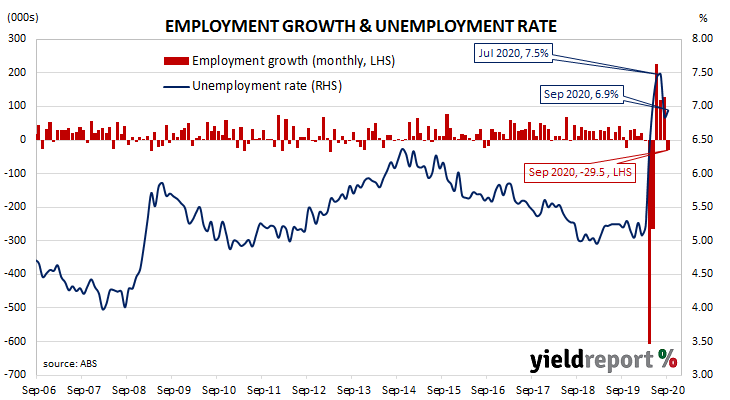Summary: Employment contracts in September; August job gains revised up; employment number falls somewhat more than expectations; declining Victorian participation limits rise of national jobless rate; national participation rate slips; more unemployed, smaller available workforce sees jobless rate up; winding back of JobKeeper, other programmes won’t be reflected until October or later; part-time, full-time jobs both down; work hours rise over month; underemployment rate up slightly;
Australia’s period of falling unemployment came to an end in early 2019 when the jobless rate hit a low of 4.9%. It then averaged around 5.2% through to March 2020, bouncing around in a range from 5.1% to 5.3%. Leading indicators such as ANZ’s Job Ads survey and NAB’s capacity utilisation estimate suggested the unemployment rate would rise in the June quarter and it did. More recent readings suggested the unemployment rate may have peaked. However, economists are generally still expecting the rate to rise.
The latest Labour force figures have now been released and they indicate the number of people employed in Australia decreased by a little more than economists had expected. The report showed the total number of people who held a job according to ABS definitions fell by 29,500 in September. The fall was in contrast to August’s 129,100 increase after it was revised up from 111,000 and a greater decline than the 30,000 loss which had been generally expected.
“As we saw in August, it is declining participation in Victoria than is putting downward pressure on the national participation rate and again limiting the rise in the national rate of unemployment,” said Westpac senior economist Justin Smirk.

Domestic Treasury bond yields fell noticeably at the long end, aided by a speech in the afternoon by RBA chief Philip Lowe. By the end of the day, the 3-year ACGB yield had lost 2bps to 0.17%, the 10-year had shed 7bps to 0.77% while the 20-year yield finished 5bps lower at 1.38%.
In the cash futures market, expectations of a lower actual cash rate, currently at 0.13%, firmed a little. At the end of the day, contract prices implied the cash rate would fall below 0.10% in November and then ease a little lower through to the end of 2021.
The participation rate slipped from August’s revised level of 64.9% to 64.8% as the total available workforce contracted by 18,300 to 13,509,400. The number of unemployed persons increased by 11,300 to 937,400; the higher unemployment number in conjunction with a lower number of people in the workforce led to the unemployment rate ticking up 6.8% to 6.9%.

